
This article was written in 2020 by Michael Müller resident of Germany. It is therefore with pleasure that I received permission from him to translate his original article written in German and publish it on my website!
Author: Michael Müller
2020
A technically minded hobbyist, recreational diver and avid user of bubble-less oxygen diving equipment tells the story of
“Aegean 1942”
The Lost First Oxygen Circulation Device by Hans Hass
By Michael Müller
To say it right away: There is no special name for Hans Hass first swim diving apparatus. The name “Aegean 1942” comes from me. I have been working with rebreathers for a long time, and so I wanted to give his very first swimming diver a very special name, because it has special technical principles and other special features, some of which we no longer find in this form in later diving equipment. At that time, Hass focused on the advantages of bubble-free diving. An oxygen apparatus offered the best prerequisites for this. This is how the type “Aegean 1942” was developed in cooperation with Drägerwerk. My aim was to trace this link between the diving rescuer and the oxygen rebreathers commonly used today.
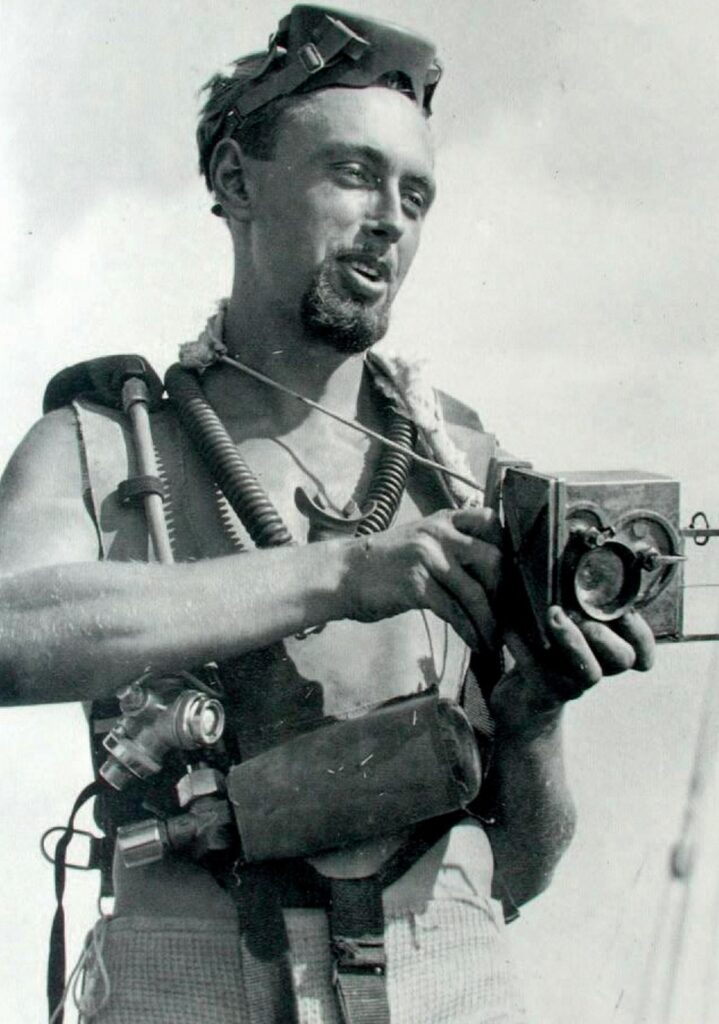
U-boat diving rescuers and small diving apparatus before 1941
The forerunners of this swimming apparatus were the submarine diving rescuers built by Drägerwerk at the time. They were used to rescue crews from sunken submarines. They were perfectly designed for this purpose. The breathing bag was placed around the neck and on the upper chest area. This changed the physical centre of gravity in such a way that they were only suitable for vertical, fast diving out, but not for free-swimming diving. After ascending to the surface, they guaranteed a fainting safe position. The fact that pure oxygen was breathed had an influence on the depth from which diving was permitted, but tests showed that even at a depth of 100 metres – according to the current state of knowledge – pure oxygen could be breathed safely for five minutes and at 50 metres even for 10 minutes.
The principle of the Drägerwerk’s small diving devices was exactly the same, but they could be used to carry out work on ships or on the seabed at shallow depths. For this purpose, the diver was additionally weighted down with iron sandals, a so-called tail weight chain and a neck weight so that he could walk around on the bottom.
Both devices were based on the principle of pendulum breathing. The gas is inhaled through a single tube and then inhaled back to the diver through the same tube. The soda lime absorbs the carbon dioxide and the used oxygen is replenished from a pressurised gas cylinder. With the smallest device of this type, it was possible to stay under water for about 30 minutes.
The rescue collars were usually made of reddish-brown, rubberised fabric and were closed in the lower part by means of a clamp fastener. The front part of the collar contained the “potassium cartridge”, which contained the soda lime in the form of a disposable cartridge, and also an oxygen cylinder without pressure reducer, with a capacity of 0.4 litres and a pressure of 150 atmospheres. The valve of the oxygen cylinder was opened by hand so that the inflow could be dosed within limits. A pressure reducer was not necessary.
Hans Hass, who had so far passed his first diving adventures free-diving or with a surface-supplied diving helmet open at the bottom, was looking for a swimming diving device after his Caribbean expedition, which would make it easier for him to stay under water. He recognised the potential of these devices and, after a test in a diving pot in 1941, arranged for the development of a corresponding swimming diving device at the Drägerwerk in Lübeck. He was able to convince the company that underwater research and floating diving represented a decisive way of opening up new sources of raw materials and food, and that such an oxygen diving device would also be very advantageous for military purposes.
For this purpose, he met several times in 1941 with the then chief engineer Hermann Stelzner of the Drägerwerk, who unfortunately died in his office on 19 October 1942, just two hours after he had finished the last sentence of the second edition of his book “Tauchertechnik”.
Oxygen re-circulation devices
The principle of oxygen devices had been known for years. Without going into detail about the advantages and disadvantages, a distinction is made between two basic construction principles: The pendulum breathing devices, whose mode of operation has already been described above, and the oxygen circulation devices, which are of interest to us here. In the latter, the breathing gas is controlled by non-return valves and fed through two breathing hoses. The valves are arranged in such a way that one tube is used for inhalation and the other for exhalation. The carbon dioxide in the scrubber is absorbed and used oxygen in the breathing circuit is replenished via a pressurised gas cylinder.
Since Hans Hass, as a researcher, publicist and filmmaker, placed particular emphasis on biological relationships and the portrayal of natural beauty under water, the technical development of the oxygen circulation devices he used is very little documented in detail, especially those of the early years. Unfortunately, the first device no longer exists. Only a few photos of it have survived.
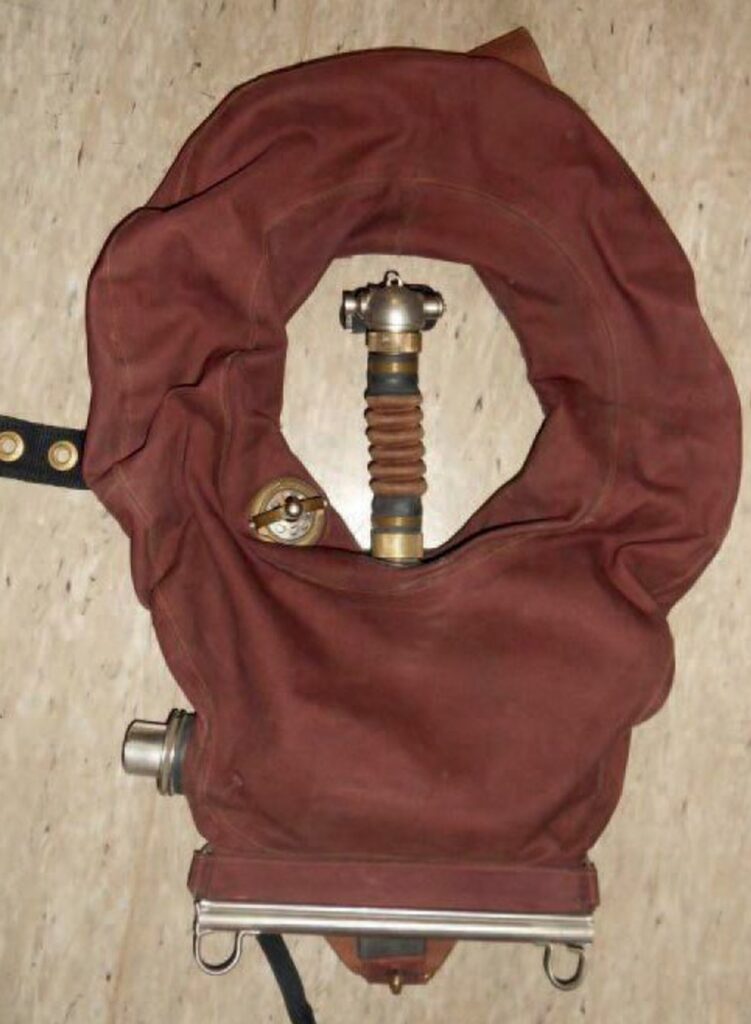
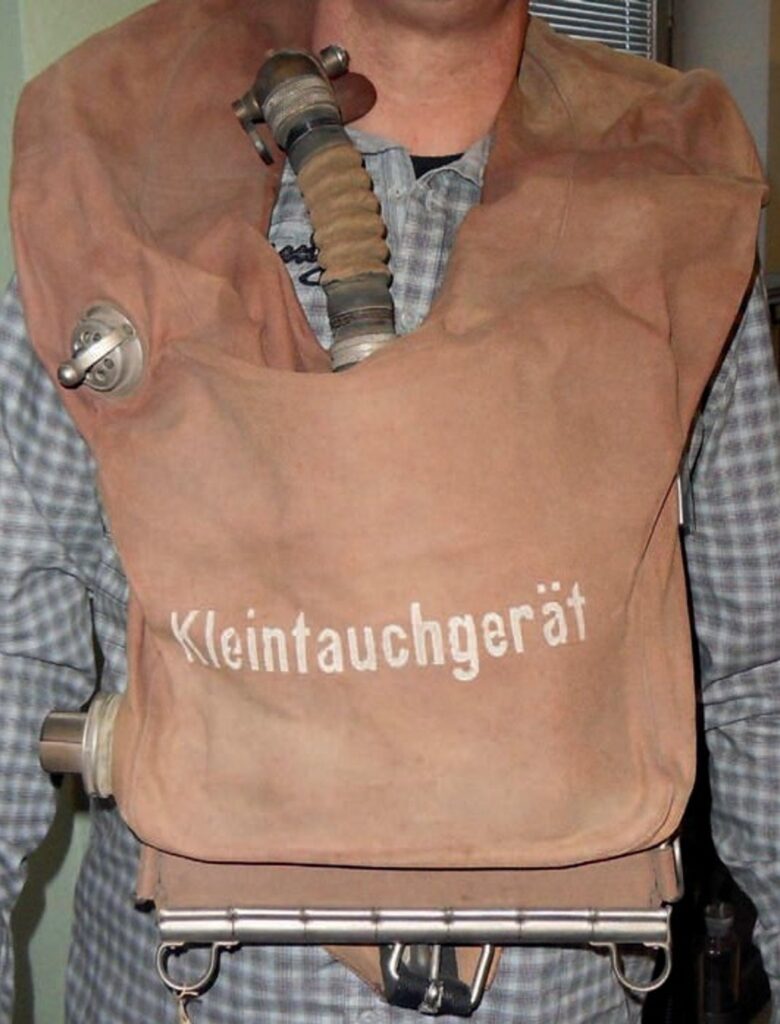
The lost 1st prototype, “Aegean 1942” model
In 1942, Hans Hass carried out his first expedition to the Aegean Sea with the expedition ship “Universitas”. There, the swimming-diving apparatus developed by Drägerwerk shortly before was used for the first time on 12 July with Ari Rosini, which enabled him to breathe freely while he was able to move weightlessly under water. Unfortunately, only extremely blurred photos and general descriptions of this device are known from various Hans Hass books. However, since this device represents the transitional phase from the diving rescuer to the first swimming diving device, it requires special attention. The following description is based on video excerpts from the Hass film “Menschen unter Haien” (People under Sharks), as well as on hitherto unknown and unpublished colour slides held by the Hans Hass Institute, which is run by Michael Jung.
Breathing bag (breathing bag)
When Hermann Stelzner developed this swimming diving apparatus, he built on his experience with the diving rescuer (Tauchretter). The breathing bag was placed on the back so that it could be used for swimming in all body positions. At the front was a chest bib with the oxygen cylinder, which was equipped with a pressure reducer or dosing valve.
The following drawing shows the basic construction of the unit:
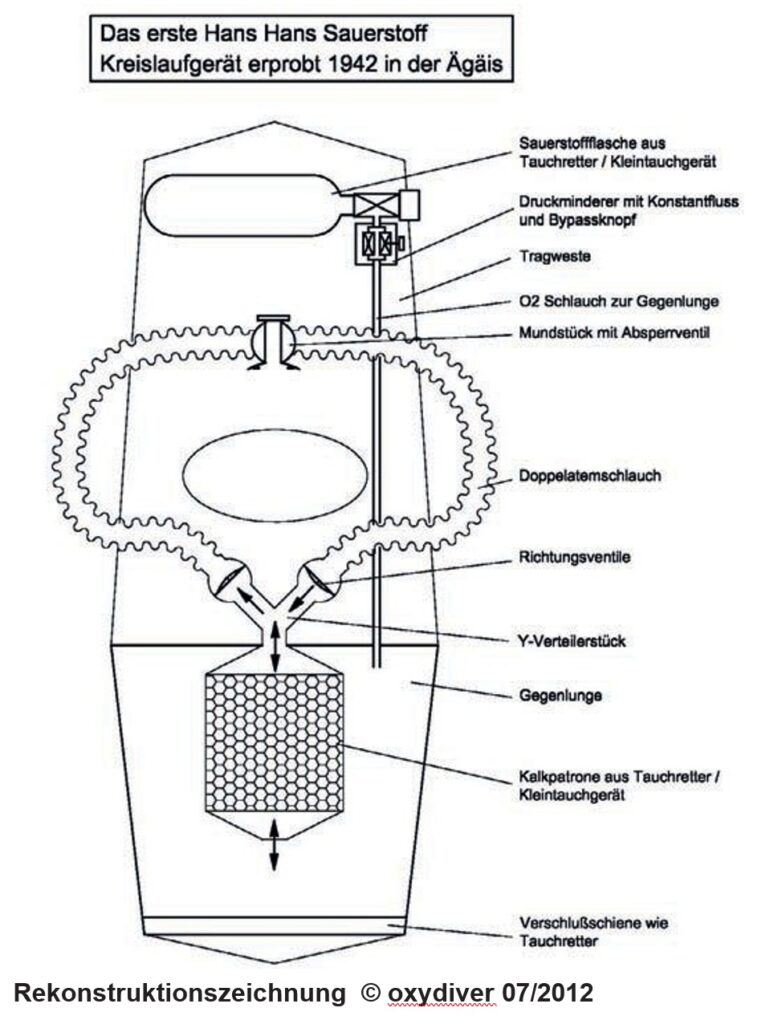
There is no reference in the literature to counterweights that had to compensate for the buoyancy of the breathing bag. So we do not know whether any were provided at all or not. It is possible that lead plates were present, as in the subsequent Dräger rebreathers, which were then attached directly below the breathing bag. For this reason, we have not shown any counterweights in our diagram.
The breathing bag, also called counter lung, is identical in material to the diving rescuer and the small diving devices. It consisted of a characteristic reddish-brown rubberised fabric and was closed at the bottom by a clamp. Below it, on the right and left, there were the fastening eyes known from the diving rescuer. There was no pressure relief valve to allow the oxygen to escape as it expanded in the opposite lung during the ascent. Instead, the gas was allowed to escape “through the corners of the mouth (past the mouthpiece), as well as through the nose” (H. Hass in “Contribution to the Knowledge of Reteporidae”) via the diving mask.
Lime container and double breathing tube
Inside the breathing bag is the lime container. This is apparently not refillable, but uses the disposable cartridges known from the small diving devices with a service life of one hour.
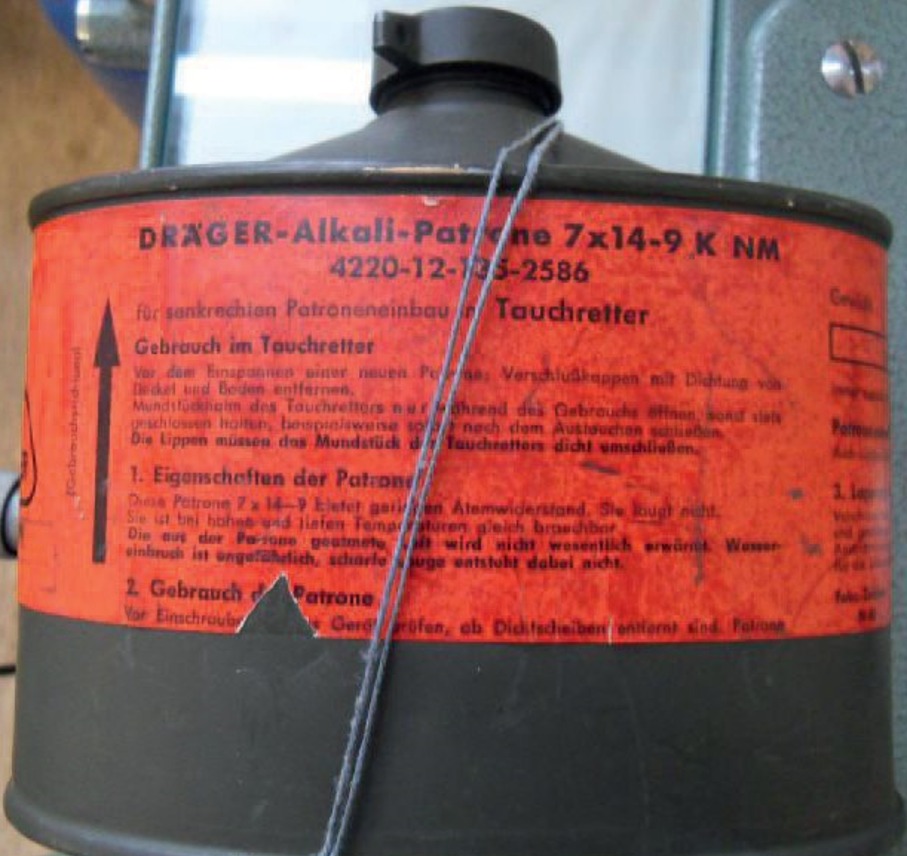
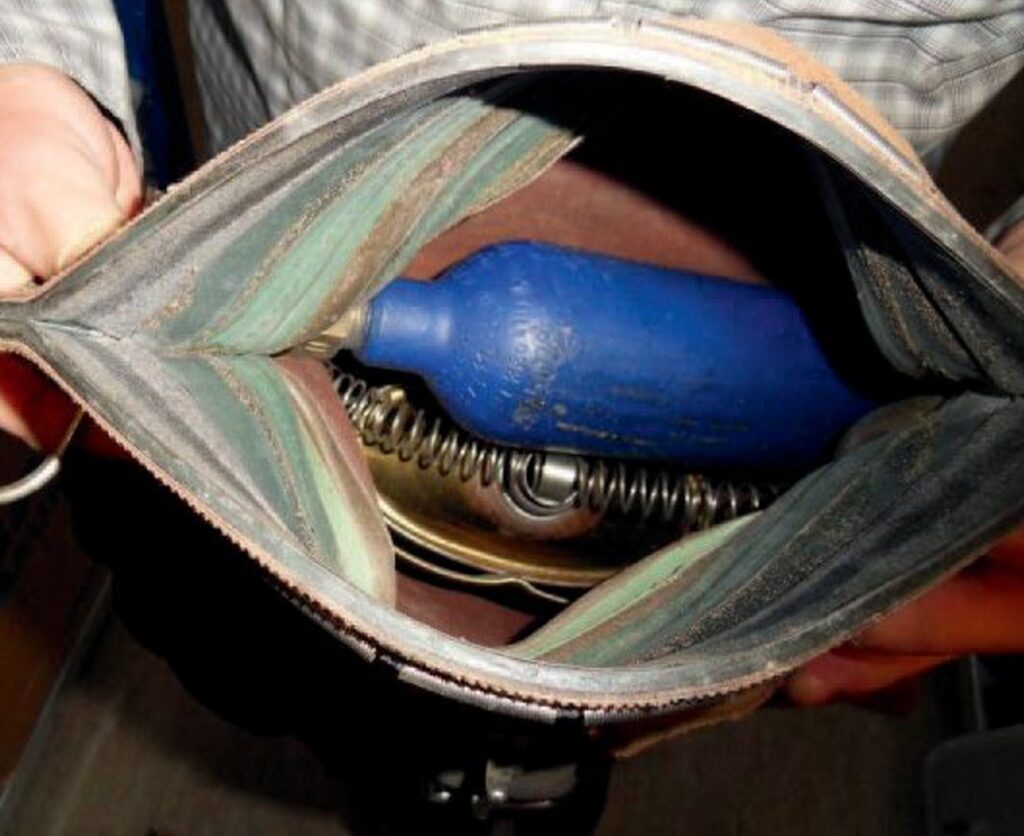
Since the problem of pendulum breathing and the associated CO2 accumulation in the breathing tube was already known at that time, Stelzner and Hass used the following trick: They divided the breathing tube shortly after the potassium cartridge with the help of a Y-piece. Mica check valves were arranged in the Y-piece (not in the mouthpiece) so that the inhaled breathing gas was led through one tube to the mouthpiece, while the exhalation led back to the potassium cartridge via the other tube. This itself was flushed twice by the breathing gas, as in the case of the diving rescuer. This achieved an effective double purification from CO2. The most important differences to all known successor models are the disposable potassium cartridge and this Y-piece.
The device thus represents the link between the pendulum breathing apparatuses and the modern recirculation devices, in which the breathing gas passes the scrubber tank only once.
Mouthpiece
The mouthpiece was the same as the one used for the Tauchretters. This had a built-in shut-off valve (plug valve) and was supplemented by an attached V-shaped distributor for the double-fold hoses.
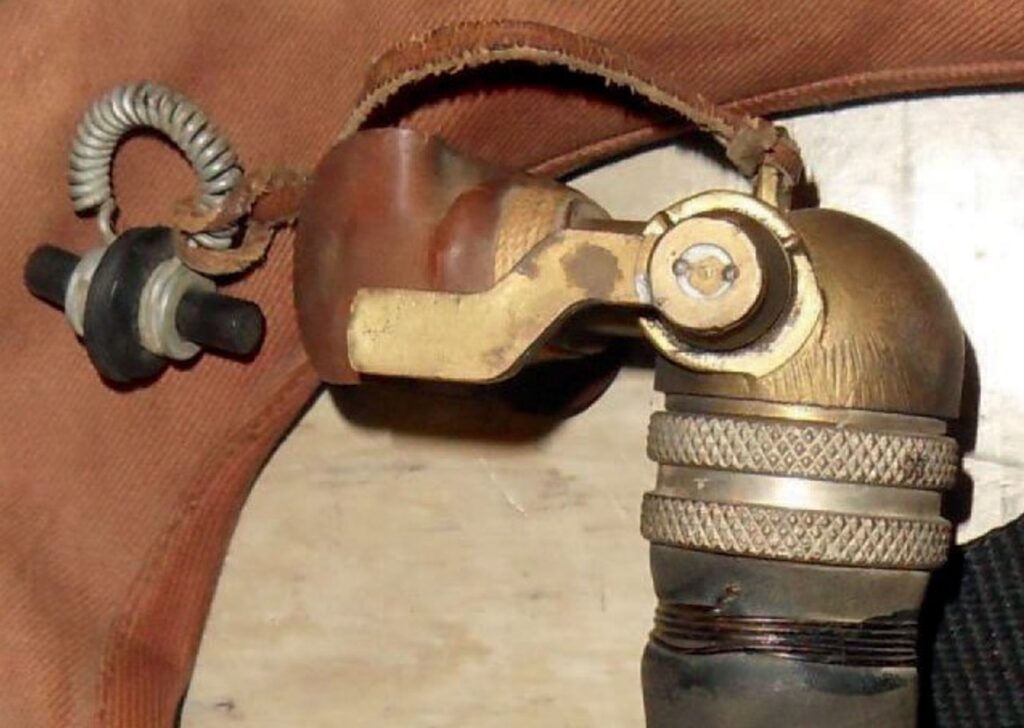
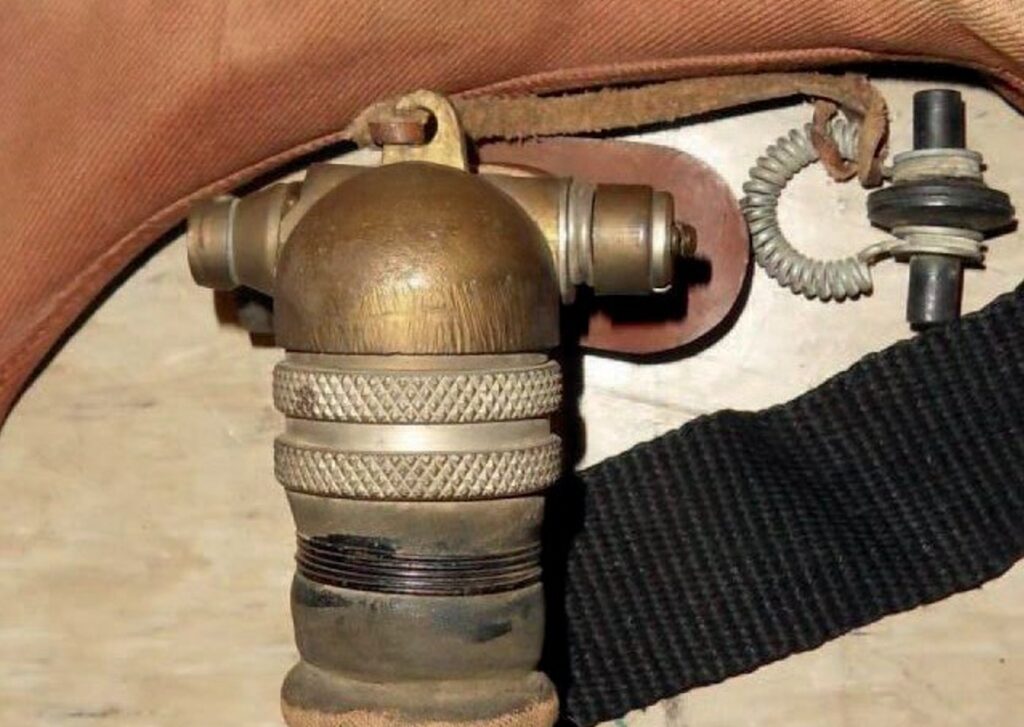
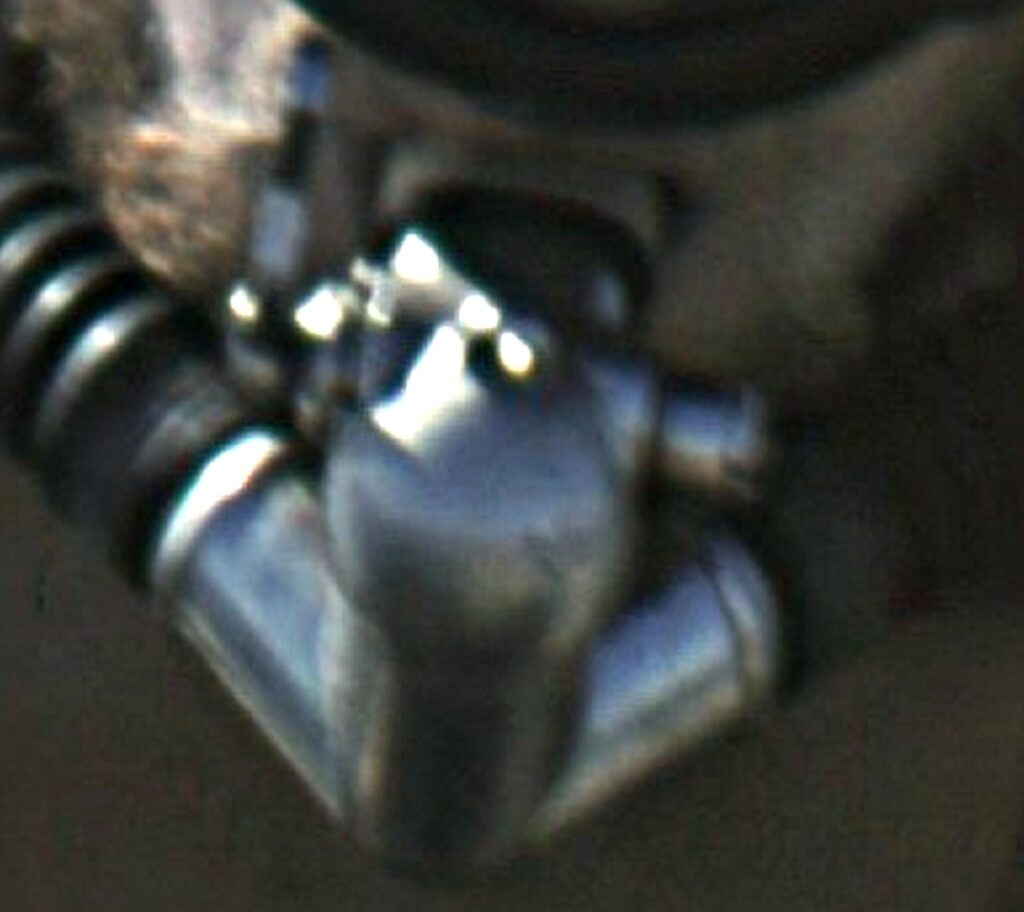
Oxygen cylinder
At first, a 0.6 litre cylinder with a pressure of 150 atü was used as an oxygen cylinder, that is 90 litres of oxygen supply, which he could manage with for up to one hour. Later, in “Men and Sharks”, Hass speaks of a 0.8 litre cylinder with 200 atü. Be that as it may, the cylinder of the swimming diving apparatus was filled by simply overflowing from a large supply cylinder, as in the case of the Tauchretter, and the pressure was then increased by means of a Dräger manual transfer pump.
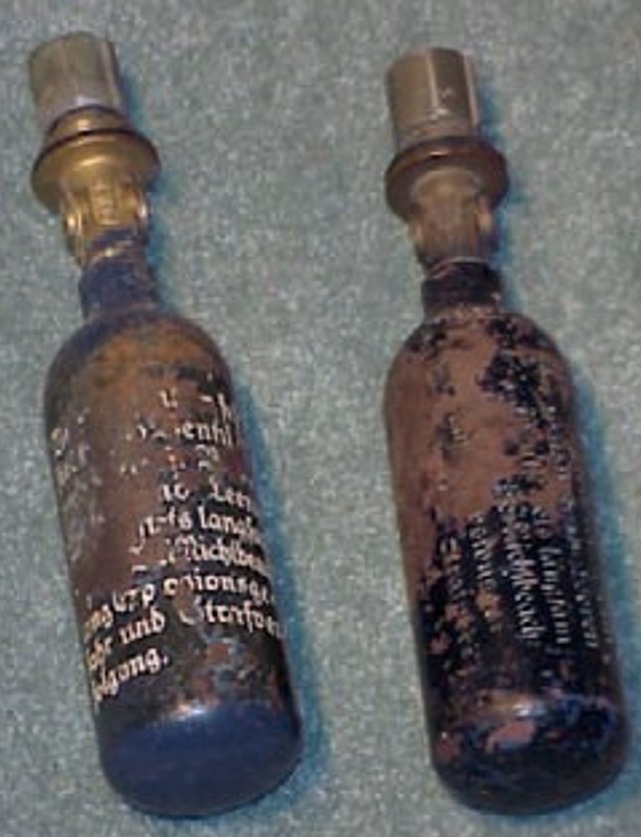
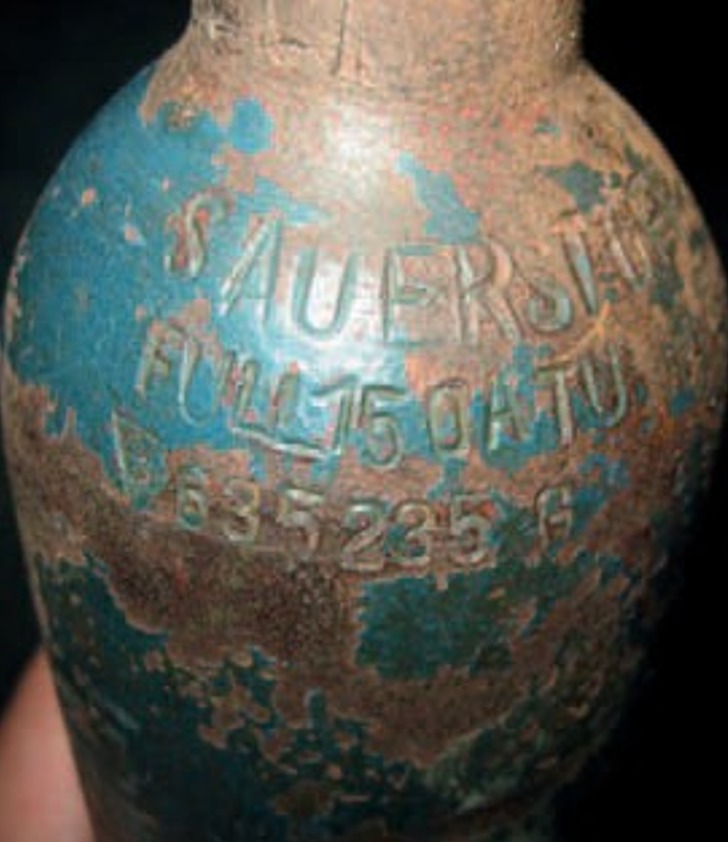
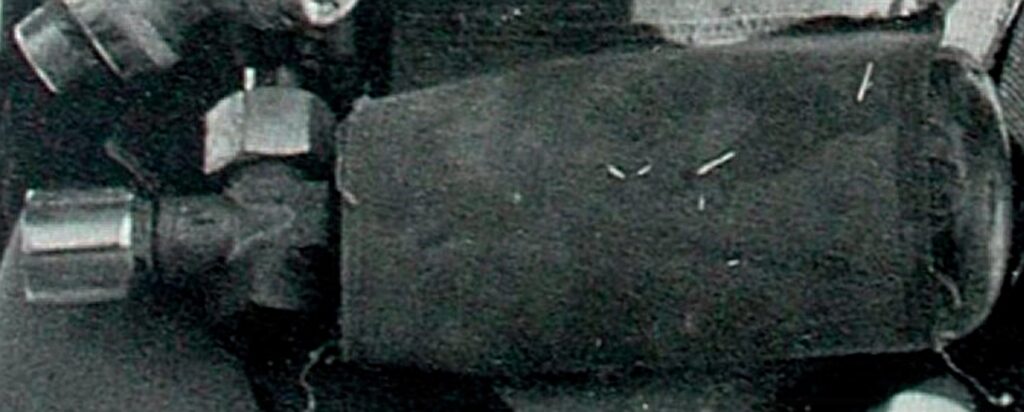
Pressure reducer
A decisive change compared to the Tauchretter is the presence of a pressure reducer. This causes a constant volume flow of about 0.9 litres per minute, which corresponds to the average resting consumption of a human being. In his dissertation, Hans Hass speaks of one litre, although he accidentally says per second. According to this, the cylinder would have been empty after only one and a half minutes… In order to allow for an increased oxygen demand and to be able to tare at the same time, the regulator also has a bypass valve with which oxygen can be added manually as needed. Hans Hass calls this the “button”. In principle, these pressure reducers were also already available and were used by Drägerwerk for self-rescuers in mines when one was buried or in a poisoned atmosphere. This was also the case, for example, with the Model 180 from 1938. The pressure reducer only had to be modified for use under water. For this purpose, it received a 90 degree elbow in the high pressure range and the hose connection to the breathing bag in the low pressure range.
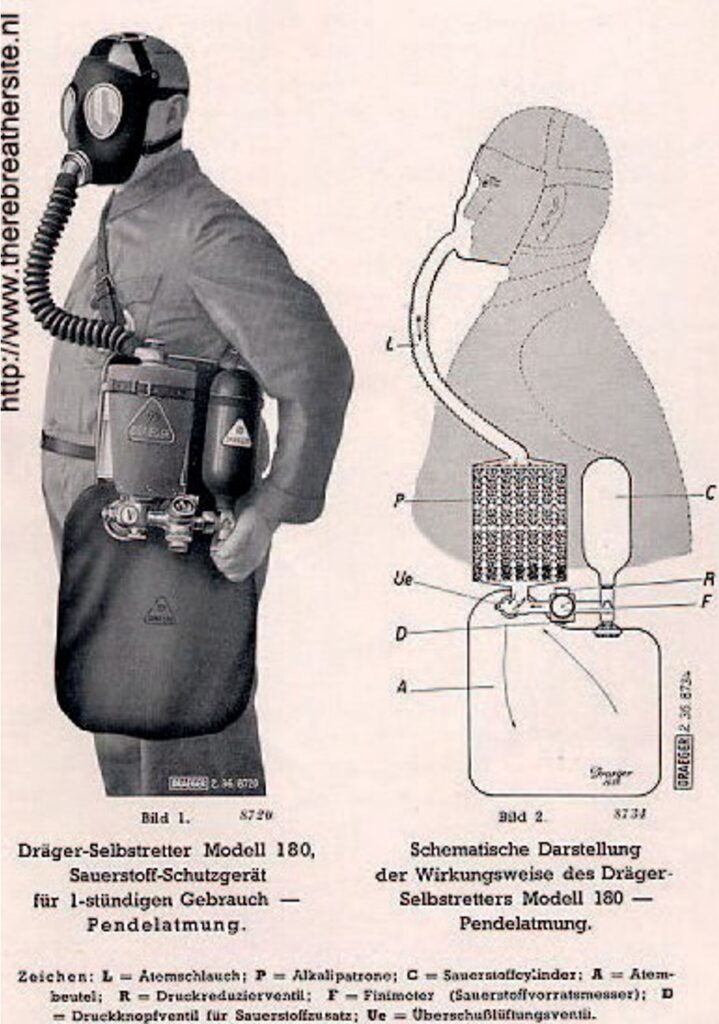
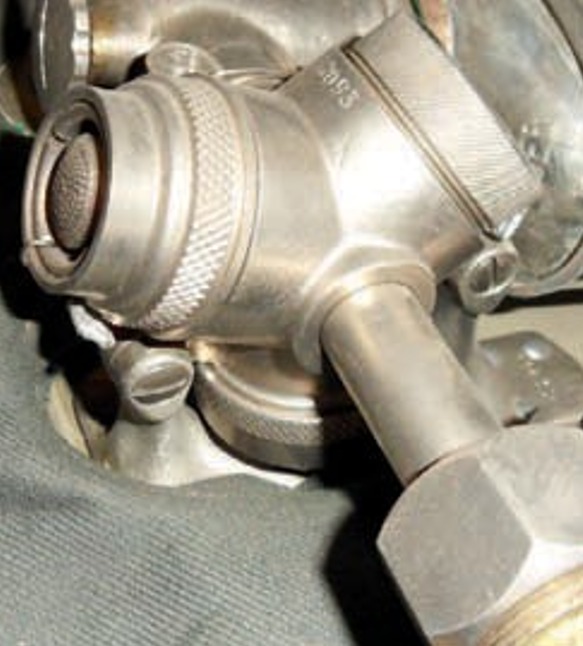
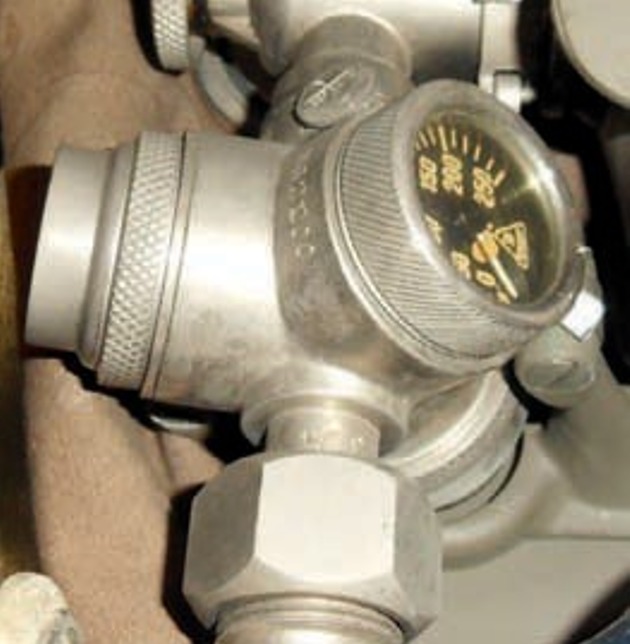
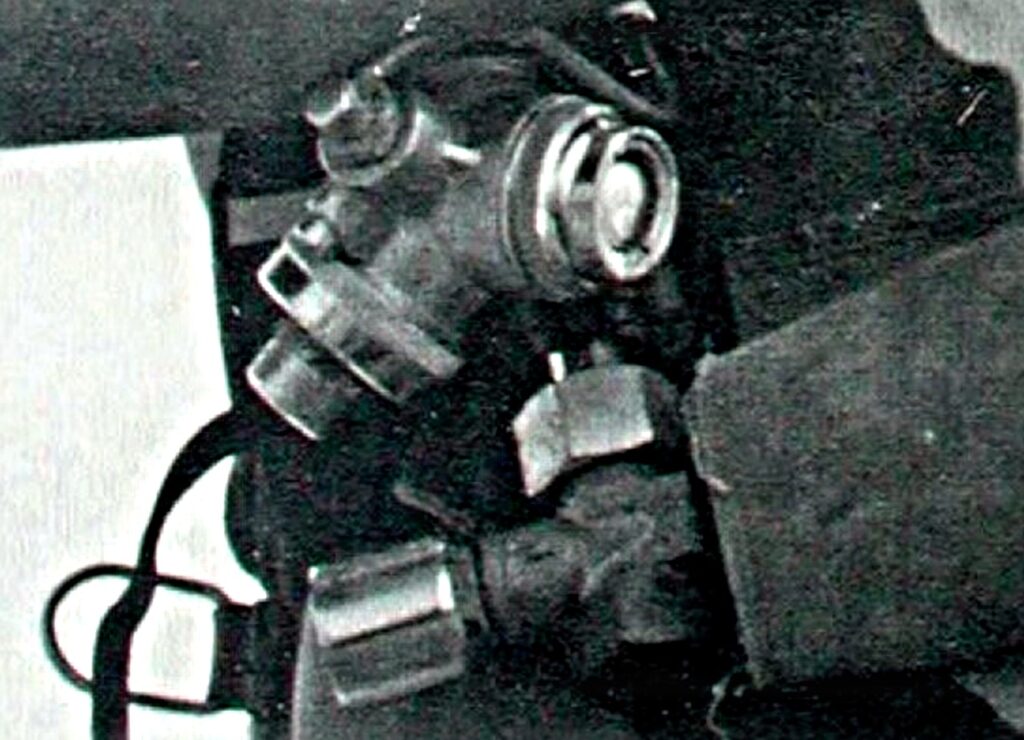
Usage and whereabouts
At the beginning of the Aegean expedition, there was only one piece of the described diving apparatus, which Hans Hass used himself. A second piece was sent to him later. Hans Hass carried out a series of self-experiments with these devices, especially with regard to possible diving depths. Regularly, depths of up to 20 metres were reached, which corresponded to the maximum depth officially allowed at the time. In the film “Menschen unter Haien” (People among Sharks), Hass talks about a maximum depth of 35 metres. In view of the current 6-metre limit for recreational divers, this is quite an extreme value! This led to at least two diving accidents that Hass survives only by luck. Once, too high partial pressure during deep diving led to oxygen toxicity, called hyperoxia, and once, too low partial pressure during ascent led to hypoxia, oxygen deprivation. In “Menschen und Haie” (People and sharks), he describes the condition at five metres deep as “as if a light switch was turned off inside me…”.
The following colour photographs from the Hans Hass Archive show detailed images of the type “Aegean 1942” for the first time:
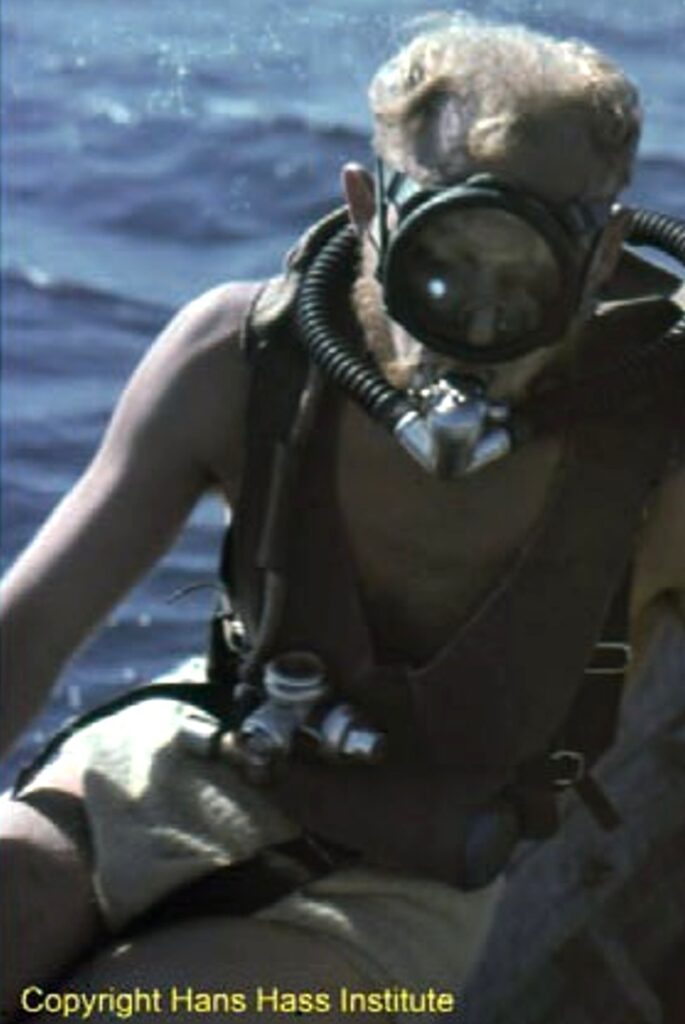
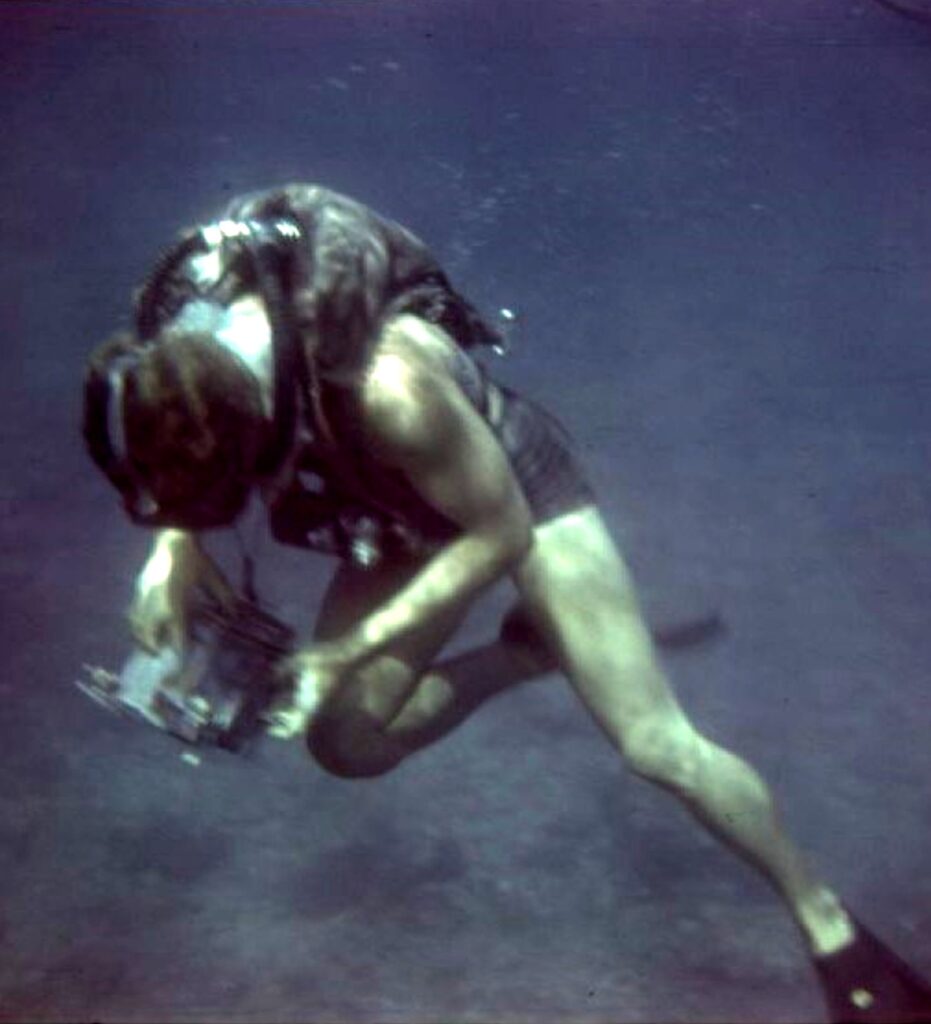
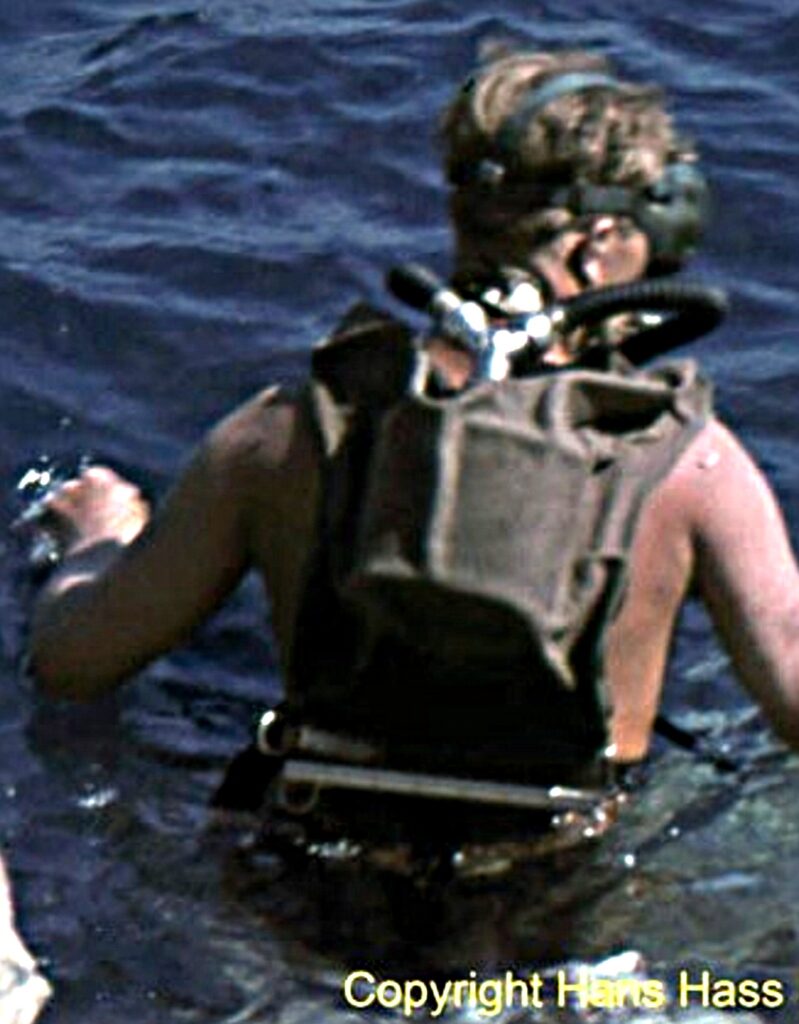
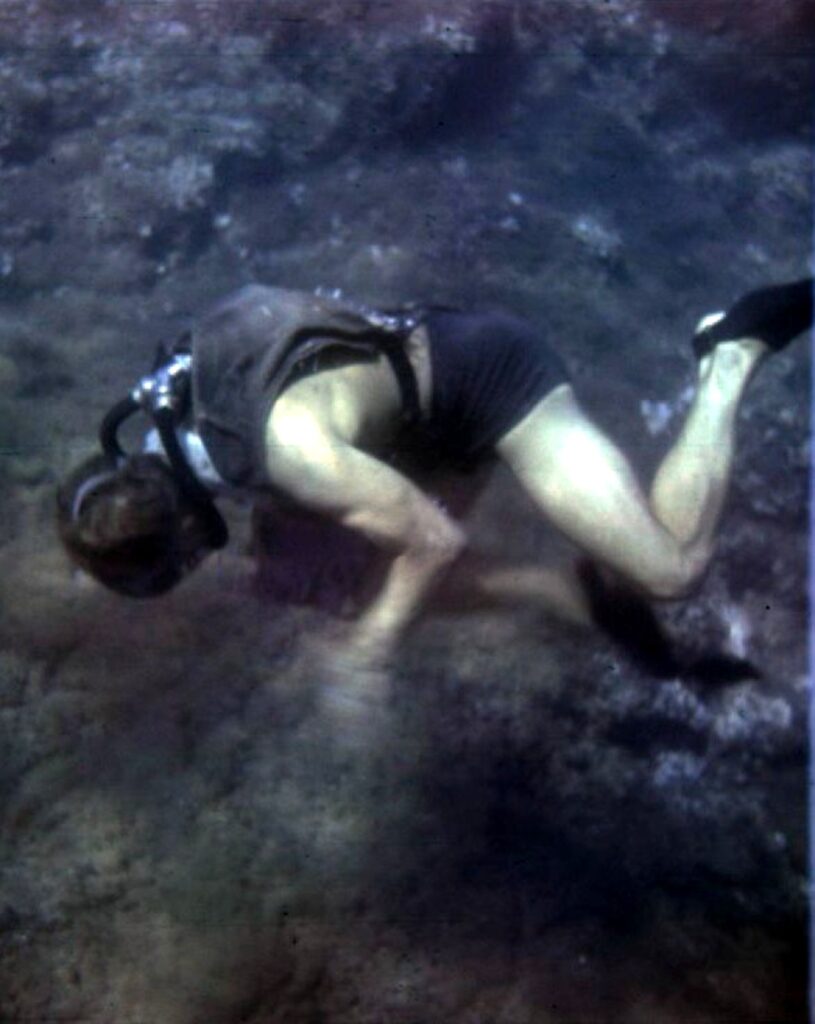
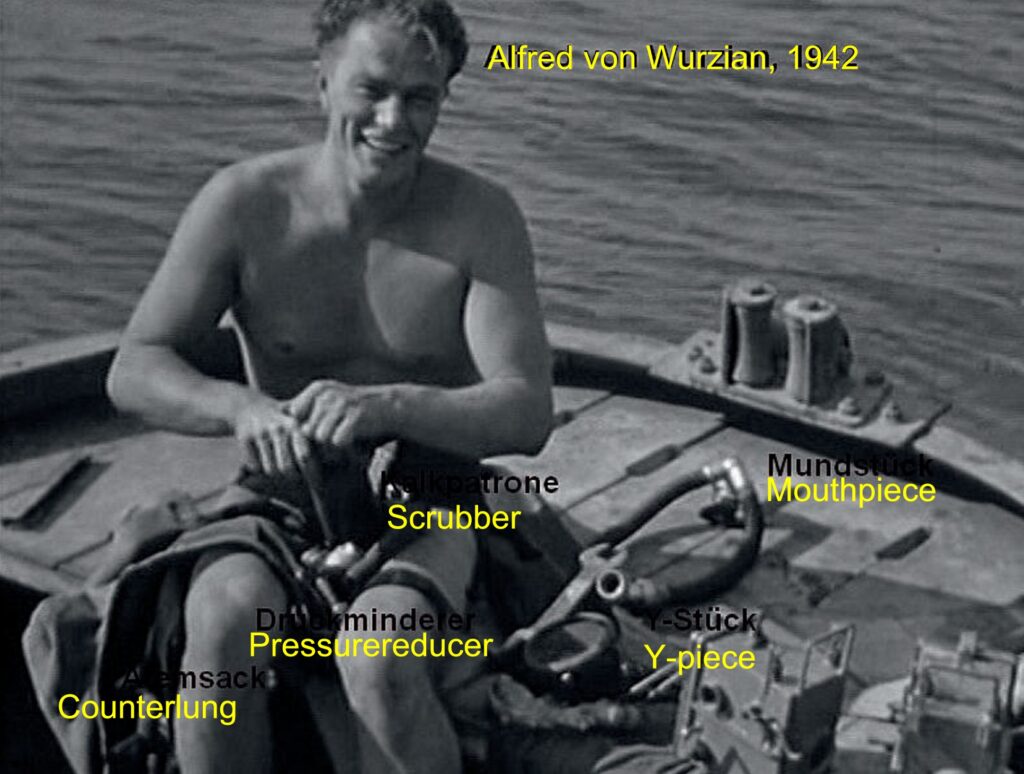
Obviously no specimen of the described very first device “Aegean 1942” has survived, as almost all equipment of the Aegean expedition fell victim to the turmoil of war and post-war. The expedition ship “Universitas” was blown up as an ammunition ship…
Outlook
For all further expeditions, Hans Hass used modern recirculation devices without a Y-piece, which combined the separate breathing hoses. The first and oldest preserved specimen is in the Aquazoo/Löbbecke Museum in Dusseldorf. The author was subsequently able to identify at least three different stages of development, including the “Model 138”, which was sold in the Federal Republic of Germany by the Barakuda company for 490 Marks and was used on the first “Xarifa” expedition.
Finally, Hans Hass stopped diving with oxygen diving equipment as far as possible, partly due to the fatal accident of Jimmy Hodges on a “Xarifa” expedition, and otherwise used compressed air diving equipment. He carried out a total of over 2000 descents to depths of up to 20 metres with oxygen rebreathers.
On the occasion of the annual meeting of the Historische Tauchergesellschaft the author will present a working replica of this interesting device “Aegean 1942”.
Further reading:
(1) Oberbergrat Ing. Gustav Ryba: Handbuch des Grubenrettungswesens, zweiter Band,
Arthur Felix Publishing House, Leipzig, 1930
(2) Hermann Stelzner: Tauchertechnik,
Charles Coleman Publishing House, Lübeck, 2nd ed., 1943
(3) Various Hans Hass books
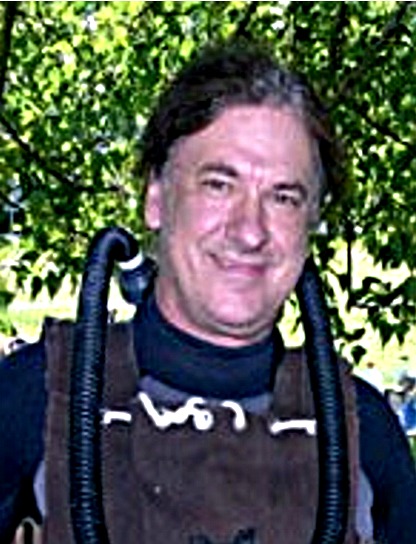
Michael Müller, born in 1958, an electrical engineering graduate. Inspired by books by Hans Hass, he started snorkeling in 1972. In the process, he gained experience in building his own camera houses and underwater photography. Compressed air diving since 1974 with the GST. In 1980, he made his first self-built regulator with single hose, from 2003 until today he built re-circulation units, which he uses almost exclusively in extremely shallow water.
Michael, auch im Namen aller Taucher möchte ich dir sehr für deine Forschungsarbeit und deine Erlaubnis danken, diesen fantastischen Artikel mit den Lesern meiner Website zu teilen!
Michael, also on behalf of all divers, I would like to thank you very much for your research work and your permission to share this fantastic article with the readers of my website!

Therebreathersite was founded by Jan Willem Bech in 1999. After a diving career of many years, he decided to start technical diving in 1999. He immediately noticed that at that time there was almost no website that contained the history of closed breathing systems. The start for the website led to a huge collection that offered about 1,300 pages of information until 2019. In 2019, a fresh start was made with the website now freely available online for everyone. Therebreathersite is a source of information for divers, researchers, technicians and students. I hope you enjoy browsing the content!
